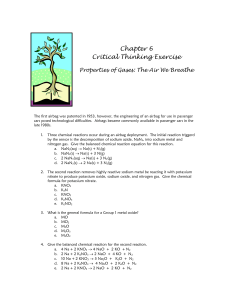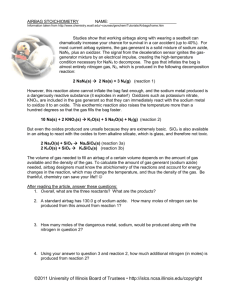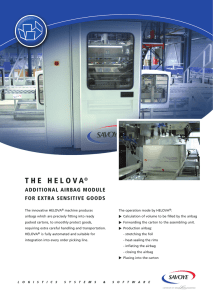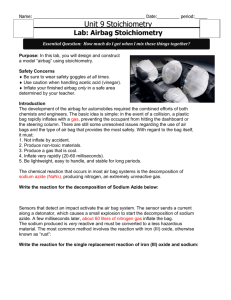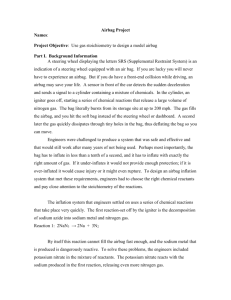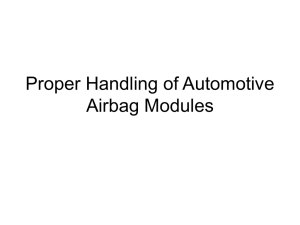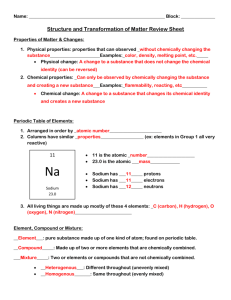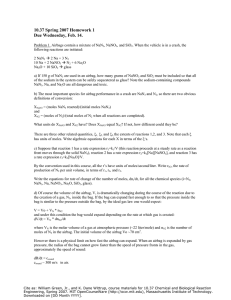airbag
advertisement
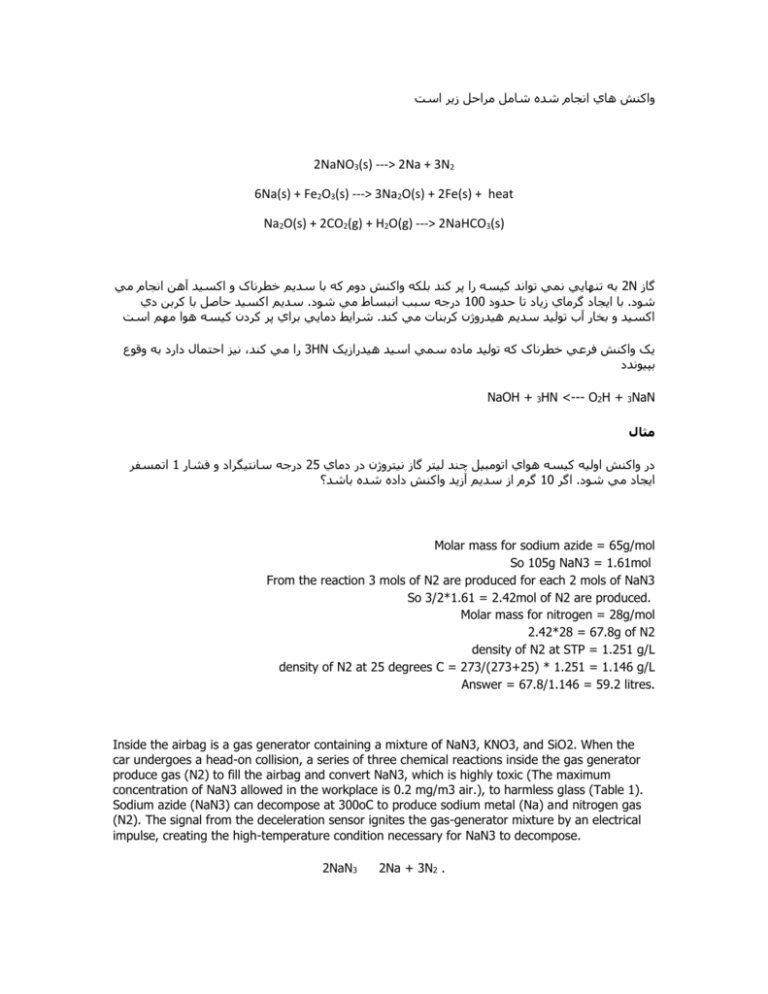
واکنش هاي انجام شده شامل مراحل زير است 2NaNO3(s) ---> 2Na + 3N2 6Na(s) + Fe2O3(s) ---> 3Na2O(s) + 2Fe(s) + heat Na2O(s) + 2CO2(g) + H2O(g) ---> 2NaHCO3(s) به تنهايي نمي تواند کيسه را پر کند بلکه واکنش دوم که با سديم خطرناک و اکسيد آهن انجام مي2N گاز سديم اکسيد حاصل با کربن دي. درجه سبب انبساط مي شود011 با ايجاد گرماي زياد تا حدود.شود شرايط دمايي براي پر کردن کيسه هوا مهم است.اکسيد و بخار آب توليد سديم هيدروژن کربنات مي کند نيز احتمال دارد به وقوع، را مي کند3HN يک واکنش فرعي خطرناک که توليد ماده سمي اسيد هيدرازيک بپيوندد NaOH + 3HN >--- O2H + 3NaN مثال اتمسفر0 درجه سانتيگراد و فشار22 در واکنش اوليه کيسه هواي اتومبيل چند ليتر گاز نيتروژن در دماي گرم از سديم آزيد واکنش داده شده باشد؟01 اگر.ايجاد مي شود Molar mass for sodium azide = 65g/mol So 105g NaN3 = 1.61mol From the reaction 3 mols of N2 are produced for each 2 mols of NaN3 So 3/2*1.61 = 2.42mol of N2 are produced. Molar mass for nitrogen = 28g/mol 2.42*28 = 67.8g of N2 density of N2 at STP = 1.251 g/L density of N2 at 25 degrees C = 273/(273+25) * 1.251 = 1.146 g/L Answer = 67.8/1.146 = 59.2 litres. Inside the airbag is a gas generator containing a mixture of NaN3, KNO3, and SiO2. When the car undergoes a head-on collision, a series of three chemical reactions inside the gas generator produce gas (N2) to fill the airbag and convert NaN3, which is highly toxic (The maximum concentration of NaN3 allowed in the workplace is 0.2 mg/m3 air.), to harmless glass (Table 1). Sodium azide (NaN3) can decompose at 300oC to produce sodium metal (Na) and nitrogen gas (N2). The signal from the deceleration sensor ignites the gas-generator mixture by an electrical impulse, creating the high-temperature condition necessary for NaN3 to decompose. 2NaN3 2Na + 3N2 . Sodium metal (Na), the other byproduct of this reaction, is an unstable substance that can undergo an explosive reaction with water at room temperature (a common demonstration in college chemistry classes). This sodium reacts with the potassium nitrate to generate additional nitrogen for the airbag in a second reaction: 10Na + 2KNO3 K20 + 5Na20 + N2 . The other products of the reaction—potassium oxide (K20) and sodium oxide (Na20)—react with the third compound of the original airbag mixture, silicon dioxide (Si02), to form alkaline silicate, or glass, a stable (unreactive) substance that is harmlessly discarded in a deployed airbag. The nitrogen gas that is generated then fills the airbag. The purpose of the KNO3 and SiO2 is to remove the sodium metal (which is highly reactive and potentially explosive, as you recall from the Periodic Properties Experiment) by converting it to a harmless material. First, the sodium reacts with potassium nitrate (KNO3) to produce potassium oxide (K2O), sodium oxide (Na2O), and additional N2 gas. The N2 generated in this second reaction also fills the airbag, and the metal oxides react with silicon dioxide (SiO2) in a final reaction to produce silicate glass, which is harmlessand stable. (First-period metal oxides, such as Na2O and K2O, are highly reactive, so it would be unsafe to allow them to be the end product of the airbag detonation.)
